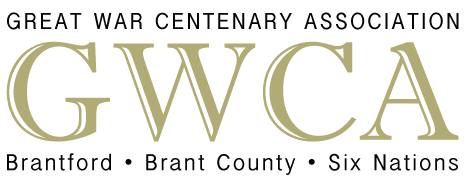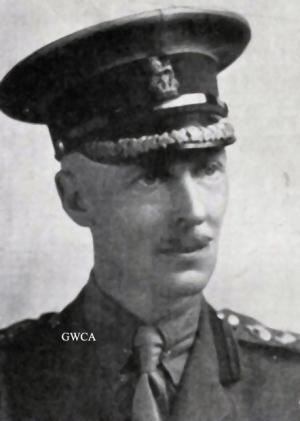BX January 5, 1915
Colonel Ashton to Command Regiment for Active Service – Popular Officer Receives Appointment – O.C. of the Thirty-Second Battery to go to England with the Third Contingent – Will Not be Leaving for Possibly Two or Three Months
Lieutenant Colonal E.C. Ashton, M.D., commanding officer of 32nd Battery Canadian Field Artillery, and late commanding officer of the 38th Regiment, Dufferin Rifles of Canada, has been offered and has accepted the command of one of the three Toronto division regiments which will go from the Toronto division with the Third Canadian Overseas Contingent. This was the announcement made here this morning, by Lieut.-Col. Ashton, prior to his departure for Toronto, where he will today confer with the higher authorities with regard to the new regiment. The headquarters of the regiment will be in Hamilton, and it is expected that Hamilton, Brantford, Dundas and St. Catharines regiments will contribute the men for it. The various units will first be instructed in their respective cities or towns and Col. Ashton will not likely take command for at least a couple of months, continuing his practice here in the meantime.
Lieut.-Col. E.C. Ashton has been connected with the military here for many years. He rose to be the commanding officer of the Dufferin Rifles, and one of the most popular who ever held that position. When his term as commanding officer expired, he was placed on the reserve of officers but he could not keep out of military affairs, and when the 32nd Battery was gazetted, he was appointed major, retaining, however, his infantry rank and precedence as lieutenant colonel.
He is one of the city’s best known physicians, a coroner, acted for a number of years with distinction on the public school board, retiring only this year, when the Board of Education goes into effect, and in many other ways has been of service to his city and country. Since taking over has sent forward far more men than though without guns or equipment, has sent forward far more men than the actual peace strength of the battery to the two Canadian contingents already organized, making by far the best record in the city in this respect.
Hundreds of friends will join in hearty congratulations to the colonel on his appointment, and it is expected that the recruiting for the new regiment will be greatly stimulated. Lieut.-Col. Ashton being very popular with all the men over whom he has in years past and at the present time, been in command.
To Star Enrollment
Enrollment of the allotment to be supplied by the 2nd Military Division to the Third Canadian Contingent will begin at once, acceding to orders received from Ottawa yesterday. It will consist of three battalions of infantry and two squadrons of cavalry. All will be enrolled from existing regiments and recruiting will be necessary only for filling up regiments thus depleted to peace strength.
One battalion will be formed from the Toronto regiments, the Q.O.R., 10th Royal Grenadiers, 48th Highlanders and 36th Peel Regiment. It is also likely that the new regiment, to be formed from the Home Guard, will be given a chance to supply a detachment. This battalion will have its headquarters at the armories, Toronto, the men sleeping at home and drilling at their headquarters. Col. C.F. Blick, of Cannington, will be in command.
Headquarters in Hamilton
The Second Battalion will have its headquarters in Hamilton, and will be commanded by Lieut.-Col. E.C. Ashton, of Brantford. No point has yet been selected for headquarters for the Third Battalion, which will be in command of Lieut.-Col. S.L. Penhorwood, but some centre in northern Ontario is likely to be chosen.
One squadron of the cavalry will be located in Toronto, the second in Hamilton. The Toronto squadron will be drawn from the G.G.B.G., and the 9th Mississauga Horse. Col. Gregory is in charge of recruiting for the cavalry.
For the present the men enrolled for the new bodies will remain at the headquarters of each contributing regiment, but it is most probable all will concentrate at Exhibition Camp when it is vacated by the present force.
BX August 18, 1956
Outstanding Military Man, Lt.-General E.C. Ashton Dies
A native of Brantford who had a long and distinguished military career, Lt.-Gen. Ernest Charles Ashton, C.M.G., died yesterday in Victoria, B.C., at the age of 82. He at one time was Chief of the General Staff.
General Ashton was born here on Oct. 28, 1973 the son of the Rev. Robert and Mrs. Alice C. (Turner) Ashton. He received his early education in Brantford, and then entered Trinity Medical College, University of Toronto. He was medalist and honors graduate in 1893 and practiced here as a physician and surgeon from 1901 to 1915.
Practiced Here
He took a deep interest in community life, and was active in the city’s public affairs. While practicing his profession in Brantford he served as alderman, and as a member of the public school board.
His outstanding military career covering a 48 year period began with his appointment, in January 1893 as a second lieutenant in the Dufferin Rifles. He rose to the rank of lieutenant-colonel, and on January 8, 1907, he became the regiment’s commanding officer, a post he retained for the next five years. He was the “Duffs,” ninth commanding officer.
Prior to that, in 1908, he had organized the 25th Brant Dragoons, a county regiment of cavalry, with three squadrons – in Brantford, Burford and Paris. This regiment was reorganized in 1920 as the 10th Brant Dragoons.
In July 1913, he organized a new howitzer battery (the 32nd later the 54th) here, and was promoted to the rank of colonel in the militia in May, 1916.
During the First World War, General Ashton proceeded to England in command of the 36th Battalion, C.E.F., commanded the 9th Reserve Canadian Infantry Brigade and the Canadian Training Division at Shorncliffe. He was promoted to Brigadier-General in March 1917.
He also commanded the 15th Canadian Infantry Brigade, from April to November, 1917 when he was recalled for duty in Canada as adjutant-general.
His first appointment to the permanent staff of the Canadian Army was adjutant-general with the rank of major-general in 1918 which appointment he held until August 1920.
He was quartermaster-general from August, 1920 to December, 1929. From January, 1930 to May 1935, he commanded Military Districts 2 and 11 (Toronto and Victoria).
Chief of Staff
In 1936 he became chief of the General Staff, a post he held for three years before becoming inspector-general. With the exception of a few months on the reserve of officers, General Ashton had 48 years of continuous commissioned service in the Canadian military forces.
For his war services he was created a Companion of the Most Distinguished Order of St. Michael and St. George, and his name was three times brought to the notice of the Secretary of State for War, for valuable services rendered.
He was created a Companion of the Most Honorable Order of the Bath in the birthday honors list in commemoration of the completion of the 25th year of the reign of the late King George V.
General Ashton is survived by his widow, the former Helen M. Weir, daughter of the late Mr. and Mrs. Weir, Brantford; a daughter, Mrs. Stephen Lloyd, in England, and a brother, Major Nelles Ashton, Grimsby.
Funeral service will be conducted Monday in Victoria.
BX August 20, 1956 - Editorial
General Ashton
Lieutenant-General E.C. Ashton, CMG, who died last Friday in Victoria, was, in many ways, the most outstanding of the many military men of Brantford who have risen through distinguished service to high rank in the Canadian Army. In the light of the record, that statement, in itself, implies a noteworthy tribute.
General Ashton was a soldier’s soldier, a man possessed from youth with a consuming interest in matters military, an interest which led, logically and enthusiastically, to his making the army his main career.
The success attending that choice is summarized in the obituary reference printed in this newspaper on Saturday. “From Subaltern to Chief of Staff” might have been the heading, for that is actually what Ernest Charles Ashton achieved in his long and eventful lifetime.
While yet a popular practicing physician in Brantford, Dr. Ashton (local men under his command in the First World War were apt to forget his military rank and affectionately call him “Doc”) early joined the Militia. To it he made marked contribution, notably through both the 25 Brant Dragoons, which he organized, and the old 38th Dufferin Rifles which he also commanded. With the coming of the First World War his decision to exchange the scalpel for the sword was made. His services in the Second World War outshone even those of the earlier conflict.
But it is his character as much as his accomplishments that attracted attention. His soldierly figure, forthright manner and demand for discipline suited him well. He said what he felt needed saying and without fear of consequences and his gift of expression could be both precise and forceful. Yet behind a rather stern exterior beat the proverbial kind heart and none knew it better than the officers and men who served under him. There was often a twinkle in the eyes that belied the lips, for General Ashton had a keen if distinctive sense of humor. Also he had a phenomenal memory for names and faces which would have stood him in remarkably good stead had he gone in for politics.
Both as doctor and officer he will be remembered here with high regard, while throughout the army, in particular, his services to his country will be appreciated as exemplary.
BX August 21, 1956
The funeral of Lieutenant-General E.C. Ashton, CMG, was conducted Monday at St. Luke’s Anglican Church, Cedar Hill, Victoria, BC with interment in the churchyard. The Rev. Canon Frederick Pike officiate.
General Ashton, a native of Brantford, at one time a medical doctor here and commanding officer successively of the 25th Brant Dragoons and the 38th Dufferin Rifles, died at his Victoria residence last Friday at the age of 82.
He served as the Canadian Army’s quartermaster-general from 1920-1929 and was chief of the general staff from 1935 to 1938. He was inspector-general of militia from 1939 until his retirement in 1941 after 48 years in the army.

